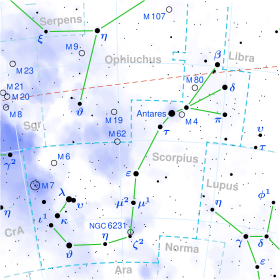| Observation data Epoch J2000 Equinox J2000 | |
|---|---|
| Constellation | Scorpius |
| Right ascension | 17h 18m 57.16483s[1] |
| Declination | −34° 59′ 23.1416″[1] |
| Apparent magnitude (V) | 5.91/7.20/10.20[2] |
| Characteristics | |
| Spectral type | K3V + K5V + M1.5V[2][3] |
| U−B color index | 0.83/???/1.17 |
| B−V color index | 1.03/???/1.57 |
| Variable type | A: suspected B: unknown C: flare star[citation needed] |
| Astrometry | |
| Radial velocity (Rv) | 6.13±0.30[4] km/s |
| Proper motion (μ) | RA: 1131.517 mas/yr[4] Dec.: −215.569 mas/yr[4] |
| Parallax (π) | 138.0663 ± 0.0283 mas[4] |
| Distance | 23.623 ± 0.005 ly (7.243 ± 0.001 pc) |
| Absolute magnitude (MV) | 7.07/8.02/11.03 |
| Details | |
| GJ 667 AB | |
| Mass | 0.73 / 0.69[5] M☉ |
| Radius | 0.76 / 0.70[2] R☉ |
| Metallicity [Fe/H] | –0.59[6] dex |
| GJ 667 C | |
| Mass | 0.327±0.008[7] M☉ |
| Radius | 0.337±0.014[7] R☉ |
| Luminosity | 0.01439±0.00035[7] L☉ |
| Temperature | 3,443+75 −71[7] K |
| Metallicity [Fe/H] | –0.59 ± 0.10[8] dex |
| Rotation | 103.9±0.7 days[9] |
| Age | 6.10±2.2[10] Gyr |
| Orbit[11] | |
| Companion | Gliese 667 B |
| Period (P) | 42.15 yr |
| Semi-major axis (a) | 1.81″ |
| Eccentricity (e) | 0.58 |
| Inclination (i) | 128° |
| Longitude of the node (Ω) | 313° |
| Periastron epoch (T) | 1975.9 |
| Argument of periastron (ω) (secondary) | 247° |
| Other designations | |
| Database references | |
| AB | |
| A | |
| B | |
| C | |
| Cb | |
| Cc | |
| Ce | |
| Cf | |
| Exoplanet Archive | Gliese 667 C |
| ARICNS | Gliese 667 A |
| B | |
| C | |
Gliese 667 (142 G. Scorpii) is a triple-star system in the constellation Scorpius lying at a distance of about 7.2 parsecs (23 light-years) from Earth. All three of the stars have masses smaller than the Sun. There is a 12th-magnitude star close to the other three, but it is not gravitationally bound to the system. To the naked eye, the system appears to be a single faint star of magnitude 5.89.
The system has a relatively high proper motion, exceeding 1 second of arc per year.
The two brightest stars in this system, GJ 667 A and GJ 667 B, are orbiting each other at an average angular separation of 1.81 arcseconds with a high eccentricity of 0.58. At the estimated distance of this system, this is equivalent to a physical separation of about 12.6 AU, or nearly 13 times the separation of the Earth from the Sun. Their eccentric orbit brings the pair as close as about 5 AU to each other, or as distant as 20 AU, corresponding to an eccentricity of 0.6.[note 1][12] This orbit takes approximately 42.15 years to complete and the orbital plane is inclined at an angle of 128° to the line of sight from the Earth. The third star, GJ 667 C, orbits the GJ 667 AB pair at an angular separation of about 30", which equates to a minimum separation of 230 AU.[8][13] GJ 667 C also has a system of two confirmed super-Earths and a number of additional doubtful candidates, though the innermost, GJ 667 Cb, may be a gas dwarf; GJ 667 Cc, and the controversial Cf and Ce, are in the circumstellar habitable zone.[14]
- ^ a b Cite error: The named reference
aaa474_2_653was invoked but never defined (see the help page). - ^ a b c Cite error: The named reference
aaa367_521was invoked but never defined (see the help page). - ^ Suárez Mascareño, A.; et al. (September 2015), "Rotation periods of late-type dwarf stars from time series high-resolution spectroscopy of chromospheric indicators", Monthly Notices of the Royal Astronomical Society, 452 (3): 2745–2756, arXiv:1506.08039, Bibcode:2015MNRAS.452.2745S, doi:10.1093/mnras/stv1441, S2CID 119181646.
- ^ a b c Cite error: The named reference
GaiaDR3was invoked but never defined (see the help page). - ^ Cite error: The named reference
mnras389_2_925was invoked but never defined (see the help page). - ^ Cite error: The named reference
aaa373_159was invoked but never defined (see the help page). - ^ a b c d Cite error: The named reference
Pineda2021was invoked but never defined (see the help page). - ^ a b Cite error: The named reference
Anglada-Escudé-2012was invoked but never defined (see the help page). - ^ Cite error: The named reference
2015MNRAS.452.2745Swas invoked but never defined (see the help page). - ^ Cite error: The named reference
2023RNAAS...7..135Swas invoked but never defined (see the help page). - ^ Cite error: The named reference
aaa341_121was invoked but never defined (see the help page). - ^ Cite error: The named reference
bowmanwas invoked but never defined (see the help page). - ^ Cite error: The named reference
Gregorywas invoked but never defined (see the help page). - ^ "Habitable Planet Reality Check: GJ 667C". Drew Ex Machina. September 7, 2014. Archived from the original on May 21, 2020. Retrieved July 18, 2019.
Cite error: There are <ref group=note> tags on this page, but the references will not show without a {{reflist|group=note}} template (see the help page).
